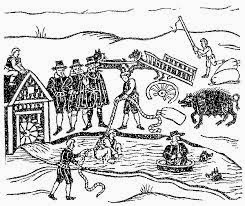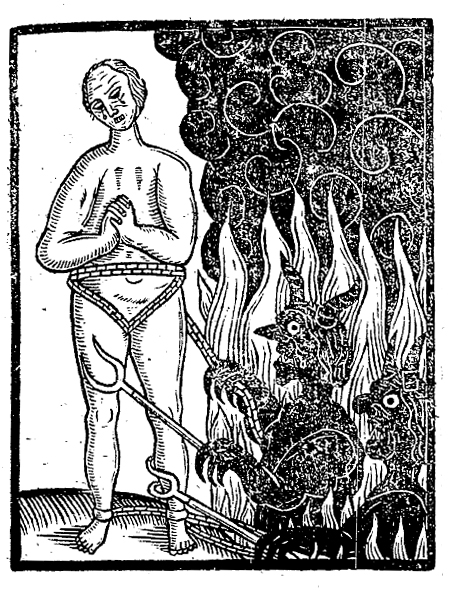.jpg) Among
the (possibly) inappropriate reading I indulged in as a young teenager (where was Harry
Potter?), I devoured the stories of Robert Neill, who wrote several books set
in the English Civil War period. His book “Witch
Bane” begins with a young woman suspected of witchcraft being publicly stripped
and submitted to trial by “pricking”. (It was a common belief held that a witch
could be discovered through the process of pricking their skin with needles,
pins and bodkins and body of the woman (or man!) was closely searched for the “witch’s
mark” to which the bodkin was applied in the belief that the person would not
feel pain or bleed when pricked). Even though “Witch Bane” is long out of
print, I won’t give away any more of the plot but the slightly salacious cover
alone was enough to grip me from the start!
Among
the (possibly) inappropriate reading I indulged in as a young teenager (where was Harry
Potter?), I devoured the stories of Robert Neill, who wrote several books set
in the English Civil War period. His book “Witch
Bane” begins with a young woman suspected of witchcraft being publicly stripped
and submitted to trial by “pricking”. (It was a common belief held that a witch
could be discovered through the process of pricking their skin with needles,
pins and bodkins and body of the woman (or man!) was closely searched for the “witch’s
mark” to which the bodkin was applied in the belief that the person would not
feel pain or bleed when pricked). Even though “Witch Bane” is long out of
print, I won’t give away any more of the plot but the slightly salacious cover
alone was enough to grip me from the start!
So
as Halloween approaches and thoughts turn to “ghosties
and ghoulies and long legged beasties and things that go bump in the night”, I
cast around for an appropriate topic for this post. There are others who are experts in the area of seventeenth century witches but,
in the memory of “Witch Bane”, I thought I might have a look at one person
whose name inspired fear throughout England of the 1640s and 1650s… Matthew
Hopkins - The Witchfinder General.
"Thou shalt not suffer a witch to live" EXODUS xxn. 18
In
1604 James I passed the the Witchcraft Statute which made “witchcraft”
a capital offence if the victim was injured. It also incorporated a number of
continental notions of witchcraft, including those of, a pact with, and worship
of, the devil and made the exhumation of bodies for “magical purposes” a crime.
This statute remained in force until 1736, when it was finally repealed.
Following the Lancashire witch trials of 1634, there was a requirement of
material proof of being a witch (some physical manifestion of a pact with the
devil).
Little
is known of Matthew Hopkins’ early life. It is
thought he was born in Little Wenham in Suffolk in the early 1620s (making him
a comparitively young man at the time he rose to infamy). It is postulated that
he studied law.
The
English Civil War (1642-1645) was at its height when Matthew first comes to
public notice. In a country torn apart by violence, politics and religion and
where fear and superstition prevailed, the moment was opportune for a young man
with a fervent belief that he had the power to rid the country of witches and
in 1644 we have the first public mention of Matthew. Essex and the Eastern
counties where Matthew worked was the seat of power for the puritan forces and
it is from this seething hot bed of religious fervour that the witch mania
rose.
 In
1644 Hopkins fell in with an already established “witch
pricker”, John Stearne. Hopkins
claimed to have overheard several witches discussing their meetings with the
devil: “…March 1644 he had some seven or eight of that horrible sect of Witches
living in the Towne where he lived, a Towne in Essex called Maningtree, with divers
other adjacent Witches of other towns, who every six weeks in the night (being
alwayes on the Friday night) had their meeting close by his house and had their
severall solemne sacrifices there offered to the Devill, one of which this
discoverer heard speaking to her Imps one night, and bid them goe to another
Witch…”
In
1644 Hopkins fell in with an already established “witch
pricker”, John Stearne. Hopkins
claimed to have overheard several witches discussing their meetings with the
devil: “…March 1644 he had some seven or eight of that horrible sect of Witches
living in the Towne where he lived, a Towne in Essex called Maningtree, with divers
other adjacent Witches of other towns, who every six weeks in the night (being
alwayes on the Friday night) had their meeting close by his house and had their
severall solemne sacrifices there offered to the Devill, one of which this
discoverer heard speaking to her Imps one night, and bid them goe to another
Witch…”
As
a consequence a trial of twenty three women was held at Chelmsford in 1645.
Four died in prison and nineteen were hung. Following the notoriety of that
trial Hopkins and Stearne became self appointed “witch
finders” (the term Witch Finder General bears no official stamp of approval).
The work of carrying out the “pricking” was done by well paid (and no doubt
zealous) female assistants. In the vacuum of proper authority caused by the war,
Hopkins and Stearne operated throughout the eastern counties with relative impunity.
.jpg) Hopkins’
favourite methods of interrogation (bearing in mind torture was by now illegal
in England) were “swimming” (where the woman was bound and thrown into a pond…if
she floated she was deemed a witch as she was being rejected the waters of baptism…if
she sank, and most likely drowned, then obviously she was innocent); cutting
with a blunt knife or sleep deprivation. Hopkins was ordered to discontinue
swimming in 1645, unless he had the subject’s permission! By far his favourite
was “pricking” (described briefly above). The victim would be shaved of all
hair and if a mole or an extra nipple was discovered, it was deemed that this
would be the means by which the witch would suckle the devil or an incubus or
imp. If found guilty the most common form of execution was hanging. It is
estimated that Hopkins was probably responsible for the death of some 200
people between 1645 and 1647.
Hopkins’
favourite methods of interrogation (bearing in mind torture was by now illegal
in England) were “swimming” (where the woman was bound and thrown into a pond…if
she floated she was deemed a witch as she was being rejected the waters of baptism…if
she sank, and most likely drowned, then obviously she was innocent); cutting
with a blunt knife or sleep deprivation. Hopkins was ordered to discontinue
swimming in 1645, unless he had the subject’s permission! By far his favourite
was “pricking” (described briefly above). The victim would be shaved of all
hair and if a mole or an extra nipple was discovered, it was deemed that this
would be the means by which the witch would suckle the devil or an incubus or
imp. If found guilty the most common form of execution was hanging. It is
estimated that Hopkins was probably responsible for the death of some 200
people between 1645 and 1647.
He
wrote a pamphlet describing his methods - The Discovery of Witches - which made
its way across the Atlantic to the new colonies and his methods were employed
in the witch trials of the New World, most notably the Salem witch trial of the
1690s.
However by 1647 Hopkins began to run into opposition. Sermons were preached
against the work of Hopkins and Stearne and his methods (and the fees he
charged for his work) were called into question by the authorities in Norfolk.
 |
| Mistley Pond |
Matthew
Hopkins died in August 1647 in his home town of Manningtee in Essex. While it
is more than likely that nothing more extraordinary than tuberculosis carried
him off, for such a controversial figure there is a legend that he met his end
after being accused of witchcraft and subjected to his own ‘swimming’
test. It is said his ghost haunts the pond at Mistley.
The last execution in England for witchcraft
was Alicia Molland who was executed in Essex in March 1684,he last conviction
in 1712
And in the spirit of Halloween here is the master of horror himself, Vincent Price, in his 1968 portrayal of Matthew Hopkins in the film "The Witchfinder General".
Sweet dreams...









